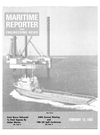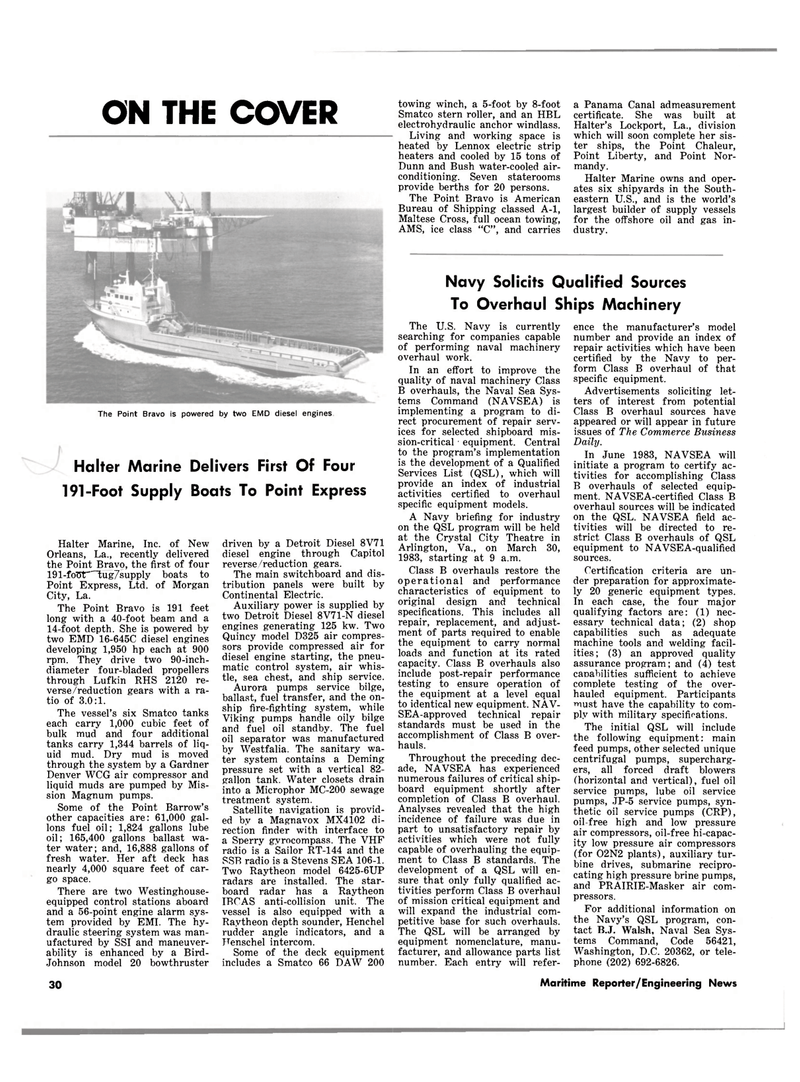
Page 26: of Maritime Reporter Magazine (February 15, 1983)
Read this page in Pdf, Flash or Html5 edition of February 15, 1983 Maritime Reporter Magazine
ON THE COVER towing winch, a 5-foot by 8-foot Smatco stern roller, and an HBL electrohydraulic anchor windlass.
Living and working space is heated by Lennox electric strip heaters and cooled by 15 tons of
Dunn and Bush water-cooled air- conditioning. Seven staterooms provide berths for 20 persons.
The Point Bravo is American
Bureau of Shipping classed A-l,
Maltese Cross, full ocean towing,
AMS, ice class "C", and carries a Panama Canal admeasurement certificate. She was built at
Halter's Lockport, La., division which will soon complete her sis- ter ships, the Point Chaleur,
Point Liberty, and Point Nor- mandy.
Halter Marine owns and oper- ates six shipyards in the South- eastern U.S., and is the world's largest builder of supply vessels for the offshore oil and gas in- dustry.
Navy Solicits Qualified Sources
To Overhaul Ships Machinery
Halter Marine Delivers First Of Four 191-Foot Supply Boats To Point Express
Halter Marine, Inc. of New
Orleans, La., recently delivered the Point Bravo, the first of four 191-fo?5f ~Tug7supply boats to
Point Express, Ltd. of Morgan
City, La.
The Point Bravo is 191 feet long with a 40-foot beam and a 14-foot depth. She is powered by two EMD 16-645C diesel engines developing 1,950 hp each at 900 rpm. They drive two 90-inch- diameter four-bladed propellers through Lufkin RHS 2120 re- verse/reduction gears with a ra- tio of 3.0:1.
The vessel's six Smatco tanks each carry 1,000 cubic feet of bulk mud and four additional tanks carry 1,344 barrels of liq- uid mud. Dry mud is moved through the system by a Gardner
Denver WCG air compressor and liquid muds are pumped by Mis- sion Magnum pumps.
Some of the Point Barrow's other capacities are: 61,000 gal- lons fuel oil; 1,824 gallons lube oil; 165,400 gallons ballast wa- ter water; and, 16,888 gallons of fresh water. Her aft deck has nearly 4,000 square feet of car- go space.
There are two Westinghouse- equipped control stations aboard and a 56-point engine alarm sys- tem provided by EMI. The hy- draulic steering system was man- ufactured by SSI and maneuver- ability is enhanced by a Bird-
Johnson model 20 bowthruster driven by a Detroit Diesel 8V71 diesel engine through Capitol reverse/reduction gears.
The main switchboard and dis- tribution panels were built by
Continental Electric.
Auxiliary power is supplied by two Detroit Diesel 8V71-N diesel engines generating 125 kw. Two
Quincy model D325 air compres- sors provide compressed air for diesel engine starting, the pneu- matic control system, air whis- tle, sea chest, and ship service.
Aurora pumps service bilge, ballast, fuel transfer, and the on- ship fire-fighting system, while
Viking pumps handle oily bilge and fuel oil standby. The fuel oil separator was manufactured by Westfalia. The sanitary wa- ter system contains a Deming pressure set with a vertical 82- gallon tank. Water closets drain into a Microphor MC-200 sewage treatment system.
Satellite navigation is provid- ed by a Magnavox MX4102 di- rection finder with interface to a Sperry gyrocompass. The VHF radio is a Sailor RT-144 and the
SSB radio is a Stevens SEA 106-1.
Two Raytheon model 6425-6UP radars are installed. The star- board radar has a Raytheon
IBCAS anti-collision unit. The vessel is also equipped with a
Raytheon depth sounder, Henchel rudder angle indicators, and a
Henschel intercom.
Some of the deck equipment includes a Smatco 66 DAW 200
The U.S. Navy is currently searching for companies capable of performing naval machinery overhaul work.
In an effort to improve the quality of naval machinery Class
B overhauls, the Naval Sea Sys- tems Command (NAVSEA) is implementing a program to di- rect procurement of repair serv- ices for selected shipboard mis- sion-critical equipment. Central to the program's implementation is the development of a Qualified
Services List (QSL), which will provide an index of industrial activities certified to overhaul specific equipment models.
A Navy briefing for industry on the QSL program will be held at the Crystal City Theatre in
Arlington, Va., on March 30, 1983, starting at 9 a.m.
Class B overhauls restore the operational and performance characteristics of equipment to original design and technical specifications. This includes all repair, replacement, and adjust- ment of parts required to enable the equipment to carry normal loads and function at its rated capacity. Class B overhauls also include post-repair performance testing to ensure operation of the equipment at a level equal to identical new equipment. NAV-
SEA-approved technical repair standards must be used in the accomplishment of Class B over- hauls.
Throughout the preceding dec- ade, NAVSEA has experienced numerous failures of critical ship- board equipment shortly after completion of Class B overhaul.
Analyses revealed that the high incidence of failure was due in part to unsatisfactory repair by activities which were not fully capable of overhauling the equip- ment to Class B standards. The development of a QSL will en- sure that only fully qualified ac- tivities perform Class B overhaul of mission critical equipment and will expand the industrial com- petitive base for such overhauls.
The QSL will be arranged by equipment nomenclature, manu- facturer, and allowance parts list number. Each entry will refer- ence the manufacturer's model number and provide an index of repair activities which have been certified by the Navy to per- form Class B overhaul of that specific equipment.
Advertisements soliciting let- ters of interest from potential
Class B overhaul sources have appeared or will appear in future issues of The Commerce Business
Daily.
In June 1983, NAVSEA will initiate a program to certify ac- tivities for accomplishing Class
B overhauls of selected equip- ment. NAVSEA-certified Class B overhaul sources will be indicated on the QSL. NAVSEA field ac- tivities will be directed to re- strict Class B overhauls of QSL equipment to NAVSEA-qualified sources.
Certification criteria are un- der preparation for approximate- ly 20 generic equipment types.
In each case, the four major qualifying factors are: (1) nec- essary technical data; (2) shop capabilities such as adequate machine tools and welding facil- ities; (3) an approved quality assurance program; and (4) test canabilities sufficient to achieve complete testing of the over- hauled equipment. Participants must have the capability to com- ply with military specifications.
The initial QSL will include the following equipment: main feed pumps, other selected unique centrifugal pumps, supercharg- ers, all forced draft blowers (horizontal and vertical), fuel oil service pumps, lube oil service pumps, JP-5 service pumps, syn- thetic oil service pumps (CRP), oil-free high and low pressure air compressors, oil-free hi-capac- ity low pressure air compressors (for 02N2 plants), auxiliary tur- bine drives, submarine recipro- cating high pressure brine pumps, and PRAIRIE-Masker air com- pressors.
For additional information on the Navy's QSL program, con- tact B.J. Walsh, Naval Sea Sys- tems Command, Code 56421,
Washington, D.C. 20362, or tele- phone (202) 692-6826.
The Point Bravo is powered by two EMD diesel engines 30 Maritime Reporter/Engineering News

 25
25

 27
27
